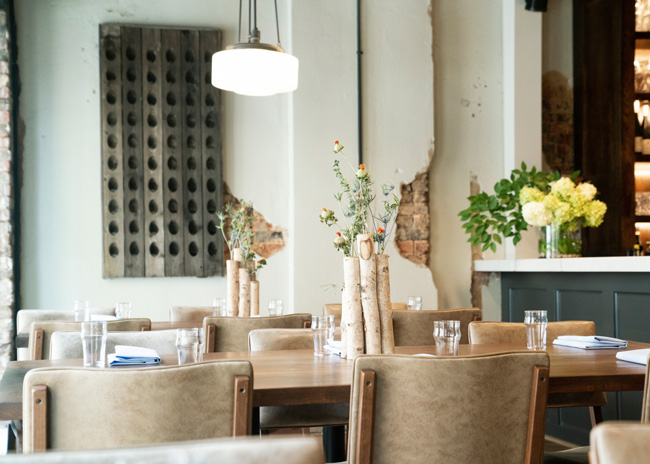Living green walls and rooftop gardens provide urban spaces with biophilic elements and appealing aesthetics that are also functional. Restaurants with limited outdoor space can utilize rooftop gardens to grow fresh vegetables and herbs, an environmentally friendly practice that also saves on ingredient costs.
Rooftop gardening is a technique used to transform a restaurant roof into a garden by adding soil and plants. This practice is traditionally used to grow vegetables and larger foliage.
Living green walls, also known as vertical gardens, green walls, living walls or Eco walls, are panels of plants grown vertically using hydroponics (without soil). This can be facilitated on structures that are either free-standing or attached directly onto walls.
Cost-Saving, Life-Giving Benefits
There are numerous benefits to rooftop gardens and living walls. In addition to providing visually-pleasing aesthetics without taking up additional floor space, these plantings bring fresh, natural elements into a space that otherwise may not have have access to nature.
Also, unlike hard, cold brick or concrete, plant surfaces don’t store up solar energy but instead reflect it. Both interior and exterior green walls can help actively cool the surrounding air in the summer by a process called evapotranspiration, which is when water is transferred to the atmosphere (or the room, if indoors) from soil via evaporation. This reduces the need to cool the building. The advantages of green walls don’t end with summer; the panels, including the growth medium, insulate the building and reduce energy costs for heating the building in winter as well. Because of this, HVAC systems don’t work as hard, extending the service life of heating and cooling equipment.
Incorporating bright, natural elements into a space by bringing nature indoors has also been proven to boost employee and customer morale. Real plants not only create oxygen but absorb sound, improving indoor acoustics. Living walls are particularly effective at sound absorption.
From a sustainability standpoint, rooftop gardens that include fresh produce cut down on carbon emissions produced when ingredients are shipped to the restaurant. In some cities, a green roof may be considered an additional permeable surface. When designed to retain and detain water, this feature also helps reduce the amount of stormwater that can potentially flood cities. This is accomplished by absorbing excess water production from heavy rainfall into the rooftop’s soil. By doing so, nearby sewers can better keep up during peak demand, which helps mediate flooding.
Rooftop gardens also can prolong the life of restaurant roofs. This is due to the required waterproof membrane and plant soil that add layers of protection from harsh UV rays and damaging temperature fluctuations.
Installation Requirements
Vertical gardens can be fitted on to both new builds and refurbishments, from extensive garden projects to large commercial developments. Completely versatile, these structures can be installed inside or attached to a building’s exterior.
Larger green walls should be designed with a drip-irrigation system, which maximizes the use of water and is set up using an automated system that times the irrigation to minimize water waste. Connections to both the water supply and drainage systems are required for automated systems. Smaller green walls can be manually watered, however it can be difficult to estimate the exact amount of water needed, as this is based on the area’s temperature and humidity.
There also needs to be enough light support for plants, although spotlighting can be added to supplement spaces that don’t provide enough natural light. Climate, shade and reflecting glass also will impact growing conditions.
Plant diversity is key, as some varieties go dormant in different seasons. Experts recommend using a blend of at least 15 foliage varieties for full coverage.
Plants typically extend 10 to 16 inches off of a living wall, depending on the varieties used, so proper clearance in the area is necessary. It’s best to avoid locating living walls by heaters, since the blowing hot air will dry plants out.
Some states have regulations on incorporating live greenery. For example, in New Jersey, for every square foot of rooftop deck that is added, the equivalent of a green roof must be constructed.
Selecting Plants and System Types
As each living green wall is individually designed for a specific project, all walls are different. Interior wall plants vary significantly from those used on exterior walls.
Typically, plants used on inside walls are tropical varieties from the southern hemisphere or warmer states like Florida. Since weather is a factor for exterior living walls, these plants must tolerate the specific climate zone. Plants are typically chosen that will survive in a zone higher than the location’s climate. For example, if a restaurant is located in Boston, zone 7a, it’s best to pick plants that could survive in a more northern climate like Vermont, zone 5a.
There are two main types of green roof systems, extensive and intensive. The extensive system type has 2- to 5-inch-deep soil tailored for succulents and lower maintenance plants, while the intensive type includes 6- to 8-inch-high foliage and offers up to 3 feet in depth. Soil profiles vary. Although less organic material drains better and is lighter weight, more organic matter will be needed in deep soil.
Because roof weight restrictions are a consideration, a structural engineer should ensure soil capacity is appropriate. Also, live loads, such as people, and dead loads, which includes plants and soil, need to be accounted for in weight calculations.
Green walls are organized into panel and tray systems, which are plug-and-play, or freestanding walls, both suitable for any space. Panel systems have plants already grown to maturity into panels and can be used inside or out in any climate. This type is easier to design and install. Tray systems are popular for indoor displays. With this type, plants are grown off-site and inserted into the wall, which offers greater versatility that can be exploited to cover entire surfaces or designed as living art. Freestanding walls are most commonly used indoors and are changed more easily, either by moving the location or changing out plants.
Care and Maintenance
When it comes to maintenance, one of the biggest challenges is access to the wall or roof for necessary maintenance after installation. Maintenance access corridors or walkways on roofs and space below living walls are needed for both equipment and personnel. This should be taken into consideration during the design process rather than after installation.
To ensure the success of a green wall or rooftop garden, regular maintenance is critical. This ensures optimal functionality of green wall irrigation and drainage systems. Plants require frequent inspection for feeding, pruning, dead-heading, weeding and replacement when necessary. Tray living wall formats typically have open irrigation systems that can collect leaves and debris, so these need more attention on a regular basis. Expertise also is required to understand the appropriate lighting and water conditions needed to keep the plants alive and flourishing. Drains need to be checked on periodically to ensure clogging is not an issue.
It is recommended that living walls and gardens be attended to by professionals at least quarterly but ideally on a monthly basis. In areas with heavier customer traffic, these components require more maintenance to be kept up and looking their best.
Because living green walls are a relatively new design component, the lifespan is difficult to ascertain. The hardware, panels and growth media are constructed to last up to 25 years, however the amount of time plants will survive is more difficult to nail down and varies greatly.
The type of system used as well as the plant type has significant impact on how long the plant can last. For tray systems, which provide a shallower space for plant root systems to grow, the plants should be switched out on a yearly basis. However, in panel systems that allow substantial room for growing root systems, plants could last for 5 to 10 years before replacement is needed.
If living plants are not possible in a given setting, synthetic plants may offer some of the aesthetic benefits of the real thing.



